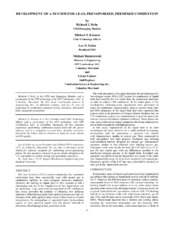| dc.description.abstract | Dry low emissions (DLE) systems employing lean, premixed combustion have been successfully used with natural gas in combustion turbines to meet stringent emissions standards. However, the burning of liquid fuels in DLE systems is still a challenging task due to the complexities of fuel vaporization and air premixing. Lean, premixed, prevaporized (LPP) combustion has always provided the promise of obtaining low pollutant emissions while burning liquid fuels such as kerosene and fuel oil. Because of the short ignition delay times of these fuels at elevated temperatures, the autoignition of vaporized higher hydrocarbons typical of most practical liquid fuels has proven difficult to overcome when burning in lean, premixed mode. The work presented in this paper describes the development of a low-nitrogen oxides (NOx) LPP system for combustion of liquid fuels that modifies the fuel rather than the combustion hardware in order to achieve LPP combustion. In the initial phase of the development, laboratory-scale experiments were performed to study the combustion characteristics, such as ignition delay time and NOx formation, of the liquid that were vaporized into gaseous form in the presence of nitrogen diluent. In phase two, an LPP combustion system was commissioned to perform pilot-scale test on commercial turbine combustor hardware. These pilot-scale tests were conducted at typical compressor discharge temperatures and at both atmospheric and high pressures. In this study, vaporization of the liquid fuel in an inert environment has been shown to be a viable method for delaying autoignition and for generating a gaseous fuel stream with characteristics similar to natural gas. Test conducted in both atmospheric and high pressure combustor rigs utilizing swirl-stabilized burners designed for natural gas demonstrated operation similar to that obtained when burning natural gas. Emissions levels were similar for both the LPP fuels (fuel oil #1 and #2) and natural gas, with any differences ascribed to the fuel-bound nitrogen present in the liquid fuels. Extended lean operation was observed for the liquid fuels as a result of the wider lean flammability range for these fuels compared with natural gas. Premature ignition of the LPP fuel was controlled by the level of inert gas in the vaporization process. | en |


